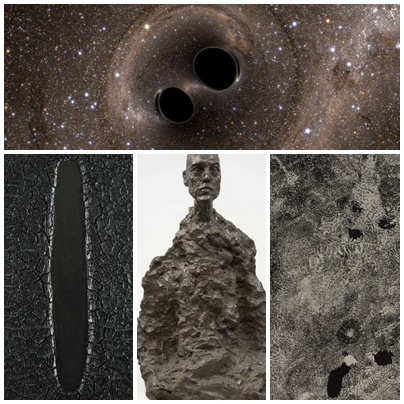"BLACK HOLE : Art and Materiality from Informal to Invisible "
Karel Appel, Hicham Berrada, Alberto Burri, Christo, Gino De Dominicis, Evelina Domnitch & Dmitry Gelfand, Jean Dubuffet, Simone Fattal, Jean Fautrier, Urs Fischer, Lucio Fontana, Alberto Giacometti, Lydia Gifford, Cameron Jamie, Asger Jorn, Hans Josephsohn, Anish Kapoor, Anselm Kiefer, Leoncillo Leonardi, Piero Manzoni, Nicola Martini, Luca Monterastelli, Movimento Arte Nucleare (Enrico Baj, Joe Colombo, Sergio Dangelo), Gastone Novelli, Tancredi Parmeggiani, Florence Peake, Carol Rama, Milton Resnick, Auguste Rodin, Medardo Rosso, Thomas Ruff, Ryan Sullivan, Antoni Tàpies, Jol Thomson, William Tucker.

GAMeC
Via San Tomaso, 53 24121 BergamoT+ 39 035 270272 e-mail:
4 October, 2018 > 6 January, 2019
 |
Activating a dialogue with the history of scientific and technological discoveries, as well as exploring the development of aesthetics theories, Black Hole showcases the work of those artists who have explored the material element’s most intrinsic significance, where the actual concept of “matter” shatters to open up a profounder idea of “matter” as an original element, as the primordial substance that constitutes everything.
In particular, the exhibition intends to narrate this dimension in three different perspectives: the first, of those who looked to the tangible, material element as a primary entity, preceding or alternative to form; second, of those who interpreted human nature as part of a broader material discourse; thirdly, of those who embarked on the penetration of matter, pushing the boundaries of materiality itself, grasping its infinitesimal and energetic dimension.
Relying on an extensive selection of artworks produced from the end of the nineteenth century to the present day, the exhibition aims to provide a single and integrated overview of this precious dialectic that shifts from the materiality of the Informal to that of the Invisible, extremes that are only superficially antithetic but in reality coexist and complement each other.
Section 1 – Informal
Scientific developments – from Heisenberg’s uncertainty principle to quantum methodology – have entered the public domain and become familiar to us, profoundly influencing artistic vision, to the point of conditioning not only the perception of things
and the world, but also the profoundest substance of artistic work. The works present in the first section interact with the development of these discoveries, and hence shun any intent to represent the world, using traditional and unusual materials not as elements to be shaped and thereby create new forms, but by virtue of their intrinsic value, of their standing as “elements in themselves”. Material configurations whose indeterminacy transmits an idea of reality as a constantly changing substance.
The origins of this research come from Jean Fautrier and his concretions of stratified colour, as well as Lucio Fontana, who cut into matter in his Nature, penetrating and ripping it to the point that it became an animated opus.
This line of research is pursued by Antoni Tàpies – among others – with his lumpy surfaces woven with tears and rips; by Alberto Burri in the tarry density of his Combustioni, and in his Cretti; in the early works of Piero Manzoni; and, decades later, by Urs Fischer’s formless Big Clay pieces; Cameron Jamie’s “oozing” statues; Ryan Sullivan’s ethereal dripping, chapped abstractions.
Section 2 – Humankind-Matter
The works of the artists present in the second section of the exhibition transmit the message that matter permeating the Universe and the element creating and composing all things also defines human nature.
This section evolves in an articulated, transversal path, with the artworks of different generations of artists installed side by side, sharing a strong material component but also a variously manifest presence of an anthropomorphic element. Works in which the human body is then primarily a “material body”, and the human figure hinted at or in decomposition becomes the vehicle for an integrated world vision, held together by the very theory of matter.
Auguste Rodin and Medardo Rosso’s plastic fusion, with images of faces and bodies emerging from indistinct bodies constitutes a significant historical precedent in the research undertaken by a series of artists who, in different forms, converged the debate on matter and exploration of the person in a single creative vision. Alberto Giacometti is one example, with his “trapped” figures, which Jean-Paul Sartre defined as always halfway between being and not being; another is Swiss sculptor Hans Josephsohn with his monolithic heads imprisoned in blocks of compact matter.
Purely pictorial face and matter return in Enrico Baj’s first informal paintings, in Jean Dubuffet’s early 1950s Dames, as well as in the works of Karel Appel and Asger Jorn, venerable members of the Co.Br.A. group, who used bright colours, fierce brushstrokes and distorted human figures, inspired by primitive art.
These masters of modernity were later flanked by the works by contemporary artists of international renown, first and foremost William Tucker, with his agglomerations of matter midway between rock and human body, and Florence Peake, whose informal sculptures were the outcome of collective performances in which body and matter seem to seek a dynamic fusion.
Section 3 – Invisible
Unlike those of the first two sections, testifying to a physical relationship with matter – slashed, coated, scratched, burnt, oozed, but “in itself” matter nonetheless – the works in the third section look to more hidden aspects of matter, invisible to our eyes, conversing with the atomistic and subatomic dimension.
Jean Dubuffet’s famous Texturologies were a starting point for an evolving debate that developed broadly in contemporary languages. These close-up, microscopic visions of a generic “material element” express a visual notion of incessant inner flurry and as research are echoed in Tancredi Parmeggiani or in the compositions of artists close to the Movimento Arte Nucleare – founded in 1951 by Enrico Baj and Sergio Dangelo, joined a year later by Joe Colombo – who rework in visual form the emotions aroused by the explosion of the atom bomb at the end of the Second World War.
From the second post-war period to contemporary times, artists have created new images of what scientific theories suggest, but what words and illustrations cannot describe. The classic notion of “matter”, applicable from the familiar level of visible objects up to molecular and atomic contexts, fades to subatomic levels, embracing the concept of energy.
Thus, artist Jol Thomson – working closely with Italy’s Gran Sasso National Laboratories, one of the world’s most important research institutes in the study of neutrinos – creates a dialogue between science and art by investigating the territories of
the material unknown, of the intangible and of the non-optical. This was a line of research that also inspired Hicham Berrada’s performances, which invite the spectator to a direct experience of the energies and forces emerging from matter, and Thomas Ruff’s Photograms of abstract compositions that arise from the awareness of the existence of a microscopic universe as well as the tangible dimension of things.
In their diversity of approaches, the works of the artists presented in this section testify to the same urgency in questioning the philosophical, perceptive and cognitive implications of contemporary revolutionary scientific discoveries.
OPENING HOURS:
Mon – Sun: 10 a.m. – 6 p.m.
Tuesday Closed
TICKETS:
Full: € 8,00
Reduced: € 6,00
Family Tickets:
1 adult +1 child: € 12,00
2 adults +1 child: € 18,00
2 adults +2 children: € 22,00
Reduced Tickets:
ABB / employees
Amici Teatro Stabile Brescia / members
ACI / members
Associazione Culturale ARTEAM / members
ASCOM Bergamo / members
Coin
Coop / members
FAI / members
Fondazione Brescia Musei / visitors
Hotel Mercure (Bergamo) / guests
Hotel Piemontese (Bergamo) / guests
Le Storie di Botticelli – Tra Boston e Bergamo / visitors
Ordine degli Architetti Provincia di Bergamo / members
Nessuno Press / members
Società Dante Alighieri – Comitato di Bergamo / members
Touring Club Italiano / members
UniAcque (CRAL) / employees
Circolo dei Dipendenti Comune di Bergamo:
Senior Card / members
Family Card / members
Free admission:
– Under 6-s
– Schools
– Art teachers
– I.C.O.M members (International Council of Museums);
– Tourist guides of the European Union with a professional license / cultural mediators;
– Italian and foreign journalists;
– Club GAMeC Members;
– Abbonamento Musei Lombardia Milano holders
– AMACI card holders
QR of this press release
in your phone, tablet

Press Office
Lara Facco P&C
Viale Gian Galeazzo, 25
20136 Milano
Tel. +39 02 36565133 | +39 349 2529989
E-mail:
Communications and Promotion – GAMeC
Manuela Blasi
E-mail:
Tel. +39 035 270272 – int. 420
Paola Colombo
E-mail:
Tel. +39 035 270272 – int. 412








